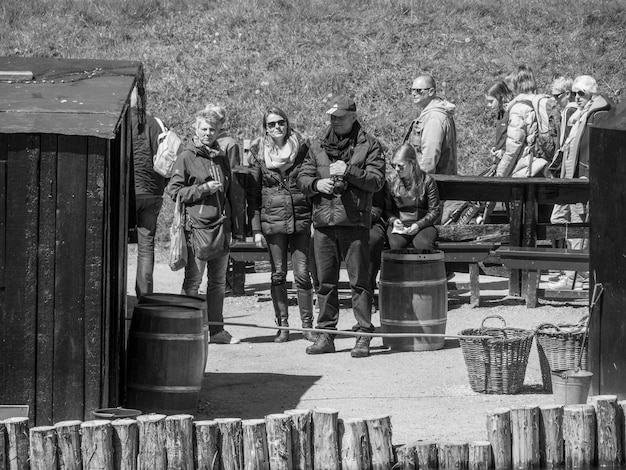Exploring the History of Military Food: From Rations to Gourmet Meals

Exploring the history of military food reveals a fascinating evolution from basic survival rations to more palatable and sometimes even gourmet meals, mirroring advancements in food technology and changing military needs.
Exploring the history of military food: from rations to gourmet meals offers a unique lens through which to view the evolution of warfare, technology, and societal expectations. What started as a basic necessity for survival has transformed into a complex and often surprisingly innovative aspect of military life. Join us as we uncover the stories behind the sustenance that fuels armies.
From Hardtack to MREs: The Early Days of Military Rations
Military rations have a long and storied past, dating back to ancient civilizations. Providing adequate and nutritious food to soldiers has always been a logistical challenge, influencing military campaigns and shaping culinary history. Let’s delve into the early days of military rations.
Ancient Armies and Basic Sustenance
In ancient times, armies primarily relied on simple, easily transportable foods. Grains, dried meats, and basic staples formed the core of their diets. Ensuring a steady supply was critical for maintaining troop morale and fighting ability.
The Rise of Hardtack
As armies grew and naval power expanded, hardtack became a staple. This dry, hard biscuit was incredibly durable, capable of withstanding long voyages and extended campaigns. While not particularly appetizing, it provided essential calories.
- Hardtack’s Composition: Typically made from flour, water, and sometimes salt, baked until rock hard.
- Challenges: Prone to weevil infestations and often required soaking in liquid to make it edible.
- Nutritional Value: Provided carbohydrates and some minerals, but lacked essential vitamins.
- Historical Significance: A defining element of military diets for centuries, symbolizing the challenges of supplying troops in the field.

The early days of military rations were characterized by a focus on preservation and portability over taste. Hardtack and salted meats were essential for survival, although far from enjoyable. These rations, while basic, played a critical role in sustaining armies and enabling military operations across vast distances.
Canned Foods and the Industrial Revolution
The Industrial Revolution brought significant advancements in food preservation, most notably the invention of canning. This innovation revolutionized military food, allowing for more varied and nutritious rations. Explore how canned foods reshaped military diets and logistics.
The Birth of Canning
In the early 19th century, Nicolas Appert developed a method for preserving food in sealed glass jars. Soon after, tin cans became the standard, enabling mass production and distribution of preserved foods.
Impact on Military Rations
Canned foods offered several advantages: longer shelf life, protection from the elements, and the ability to include a wider range of ingredients. This led to the introduction of canned meats, vegetables, and soups into military rations.
- Improved Nutrition: Canned goods provided vitamins and minerals not readily available in traditional preserved foods.
- Increased Variety: Soldiers no longer had to rely solely on hardtack and salted meats.
- Logistical Benefits: Easier storage and transportation reduced spoilage and simplified supply chains.
Canning significantly improved the nutritional content and variety of military rations. Soldiers now had access to foods that were both more palatable and better suited to maintaining their health during rigorous campaigns. This technological leap was pivotal in supporting larger and more mobile armies.
World War I and II: Innovations and Challenges
The World Wars pushed the boundaries of military food technology even further. These global conflicts demanded vast quantities of rations that were not only nutritious but also lightweight and durable. This era saw the introduction of new preservation techniques and innovative food products. Let’s examine the innovations and challenges of feeding troops during these wars.
The Development of K-Rations
During World War II, the U.S. military developed the K-ration, a lightweight, compact meal designed for short-term use. It included a variety of items such as biscuits, canned meats, chocolate, and coffee.
Challenges in Distribution and Palatability
Despite advancements, challenges remained. Maintaining supply lines under enemy fire was difficult, and the taste of rations often left much to be desired. Soldiers frequently supplemented their rations with foraged food or items acquired from local populations.

World War I and II spurred significant innovation in military food. The K-ration and other developments provided soldiers with convenient and relatively nutritious meals, though palatability remained a consistent challenge. These conflicts highlighted the critical role of food in maintaining troop morale and operational effectiveness.
The Vietnam War and the Birth of the MRE
The Vietnam War brought new demands for military rations in a challenging environment. The need for long-lasting, self-contained meals led to the development of the Meal, Ready-to-Eat (MRE). Explore the evolution and impact of this iconic military ration.
The Evolution of Self-Contained Meals
MREs were designed to provide a complete and balanced meal in a single, lightweight package. They included entrees, side dishes, desserts, and accessories such as utensils and condiments.
Improvements and Criticisms
Over the years, MREs have undergone numerous improvements to enhance taste, nutritional value, and variety. However, they have also faced criticism for being bland, repetitive, and sometimes causing digestive issues.
- Nutritional Completeness: Designed to meet the daily caloric and nutritional needs of soldiers in the field.
- Variety and Palatability: Continuous efforts to introduce new menus and improve the taste of existing items.
- Durability and Convenience: Able to withstand harsh conditions and require no cooking or preparation.
The MRE revolutionized military food by providing soldiers with self-contained, nutritious meals that could be consumed anywhere, anytime. While continuous improvements are made, the MRE remains a cornerstone of modern military logistics and troop sustenance.
Modern Military Cuisine: Gourmet Meals and Specialized Diets
Today, military cuisine is about more than just survival. Modern military dining facilities offer a wide range of options, including gourmet meals and specialized diets, catering to the diverse needs and preferences of service members. Let’s examine the transformation of military food into a culinary experience.
The Rise of Military Dining Facilities
Modern military bases often feature state-of-the-art dining facilities that resemble civilian restaurants. These facilities offer a variety of cuisines, including international dishes, vegetarian options, and healthy meal choices.
Catering to Specialized Diets
The military recognizes the importance of catering to the individual dietary needs of service members. Special diets are available for athletes, those with medical conditions, and individuals with specific religious or ethical beliefs.
Modern military cuisine reflects a growing emphasis on nutrition, variety, and personal preferences. From gourmet meals in dining facilities to specialized diets tailored to individual needs, the military is committed to providing service members with the sustenance they need to perform at their best. This evolution marks a significant departure from the basic rations of the past.
The Future of Military Food: Technology and Sustainability
The future of military food is focused on leveraging technology and sustainable practices to create even more nutritious, palatable, and environmentally friendly rations. From 3D-printed meals to lab-grown meats, the possibilities are endless. Discussing emerging trends and innovations shaping the future of military sustenance is important.
Emerging Technologies in Food Production
Researchers are exploring new technologies such as 3D food printing, which allows for the creation of customized meals with precise nutritional content. Lab-grown meats and plant-based protein sources are also being investigated as sustainable alternatives to traditional rations.
Sustainability and Environmental Impact
The military is increasingly focused on reducing the environmental impact of its food supply chain. This includes efforts to minimize waste, use sustainable packaging, and source food locally whenever possible.
- Personalized Nutrition: Tailoring rations to meet the specific needs of individual service members.
- Sustainable Sourcing: Reducing reliance on traditional agriculture and promoting environmentally friendly practices.
- Enhanced Palatability: Utilizing advanced food science techniques to improve the taste and texture of rations.
The future of military food is poised for exciting advancements. By embracing technology and prioritizing sustainability, the military aims to provide future generations of service members with rations that are not only nutritious and convenient but also environmentally responsible. These innovations will ensure that troops are well-fueled and ready to meet the challenges of the 21st century and beyond.
| Key Point | Brief Description |
|---|---|
| 🍪 Hardtack Era | Durable but unappetizing staple ration. |
| 🥫 Canned Foods | Improved nutrition and variety through preservation. |
| MRE Revolution | Self-contained meals for battlefield use, evolving in taste and nutrition. |
| 🍽️ Modern Cuisine | Gourmet options & specialized diets reflect diverse military needs. |
Frequently Asked Questions
▼
Hardtack was a simple biscuit made from flour, water, and sometimes salt. It was used because it was incredibly durable and could withstand long voyages and extended campaigns without spoiling. It provided essential calories, though it was not particularly palatable.
▼
Canning revolutionized military rations by allowing for the preservation of a wider variety of foods. This led to improved nutrition and greater variety in soldiers’ diets, which boosted morale and overall health during military campaigns, and simplified logistics.
▼
An MRE, or Meal, Ready-to-Eat, is a self-contained, complete meal designed for military personnel in the field. MREs were developed during the Vietnam War to provide a convenient and nutritious option for soldiers when cooking facilities were not available.
▼
Modern military dining facilities often resemble civilian restaurants, offering a wide range of cuisines and healthy meal options. They cater to diverse preferences and dietary needs, including vegetarian, vegan, and specialized diets for athletes or those with medical conditions.
▼
The future of military food focuses on advancements in technology and sustainable practices. Innovations such as 3D food printing and lab-grown meats are being explored to create personalized, nutritious, and environmentally friendly rations for future generations of service members.
Conclusion
From the humble hardtack of ancient armies to the advanced MREs and gourmet meals of today’s military, the journey of military food reflects technological advancements and evolving nutritional needs. As we look to the future, innovations in food science and sustainable practices promise to further transform how the military sustains its forces, ensuring they are well-fed and ready to face the challenges ahead.





